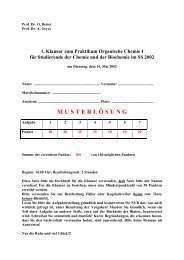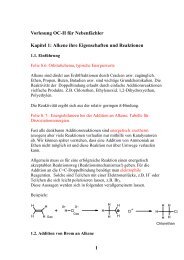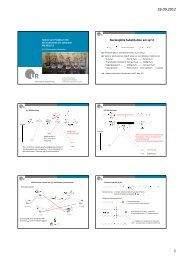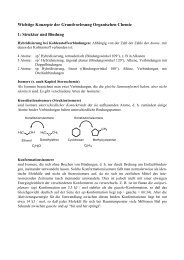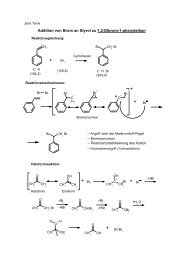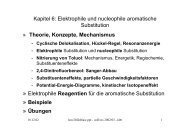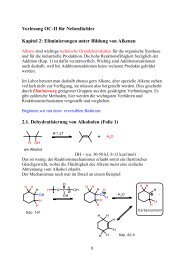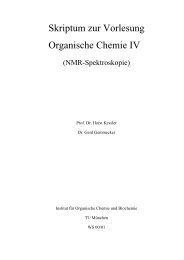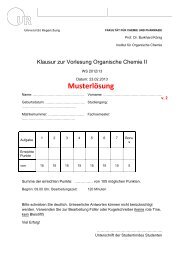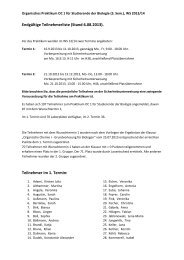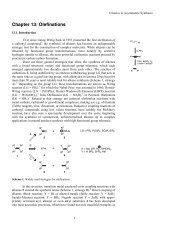Photochemistry - Organic Syntheses with Light - Institut für ...
Photochemistry - Organic Syntheses with Light - Institut für ...
Photochemistry - Organic Syntheses with Light - Institut für ...
Create successful ePaper yourself
Turn your PDF publications into a flip-book with our unique Google optimized e-Paper software.
Prof. Dr. Burkhard König, <strong>Institut</strong> <strong>für</strong> Organische Chemie, Universität Regensburg 1<br />
<strong>Organic</strong> <strong>Photochemistry</strong>
Prof. Dr. Burkhard König, <strong>Institut</strong> <strong>für</strong> Organische Chemie, Universität Regensburg 2<br />
Additional reading list:<br />
J. Mattay, A. G. Griesbeck: Photochemical Key Steps in <strong>Organic</strong> Synthesis, Wiley-VCH,<br />
1994.<br />
F. A. Carey, R. J. Sundberg, Advanced <strong>Organic</strong> Chemistry, Plenum Publishing Corporation,<br />
2000.<br />
N. J. Turro, Modern Molecular <strong>Photochemistry</strong> 1991, University Science Books, Mill-Valley,<br />
California.<br />
A. Gillbert, J. Baggott, Essentials of Molecular <strong>Photochemistry</strong> 1991, Blackwell Scientific<br />
Publications, London.<br />
M. Klessinger, J. Michl, Excited States and <strong>Photochemistry</strong> of <strong>Organic</strong> Molecules, Wiley-<br />
VCH, 1994, New York.<br />
B. Valeur, Molecular Fluorescence, Wiley-VCH, 2002, Weinheim.<br />
Essential criteria for all photochemical reactions:<br />
� Molecule must absorb light<br />
� Radiation energy must match energy difference of ground and excited state<br />
Typical absorption range of some important classes of organic compounds:<br />
Simple alkene 190 - 200 nm<br />
Acylic diene 220 - 250 nm<br />
Cyclic diene 250 - 270 nm<br />
Styrene 270 - 300 nm<br />
Saturated ketones 270 - 280 nm<br />
α,β-Unsaturated ketones 310 - 330 nm<br />
Aromatic ketones/aldehydes 280 - 300 nm<br />
Aromatic compounds 250 - 280 nm<br />
<strong>Light</strong> is absorbed by a molecule – what happens?<br />
The electronic configuration changes. The Franck-Condon principle says that the heavy atom<br />
nuclei do not change their positions. This leads to an initial geometry of the excited state<br />
which is usually not the energy minimum. During excitation the electron spin remains unchanged.<br />
Spin inversion during excitation is forbidden by quantum mechanics and therefor<br />
unlikely.<br />
Right after the excitation several things may happen. 1) Vibronic relaxation brings the<br />
molecule quickly into the new energy minimum structure for the excited state. Energy is<br />
released into the solvent. 2) Intersystem crossing leads to triplet states by spin inversion.
Prof. Dr. Burkhard König, <strong>Institut</strong> <strong>für</strong> Organische Chemie, Universität Regensburg 3<br />
Again, the new energy minimum is reached by vibrational relaxation. 3) Emission of light and<br />
return to the ground state (luminescence, fluorescence, phosphorescence). 4) Quenching of<br />
the exited state: Energy is transferred to another molecule. Usually we observe diffusion<br />
controlled dynamic quenching by collision. Investigation of this is possible by the Stern-<br />
Vollmer plot (1/quantum yield vs concentration of quencher). Gives a strait line for diffusion<br />
controlled quenching; large excess of quencher usually needed (1000 times excess).<br />
5) Radiationless deactivation. Molecule goes back to ground state by vibrational (thermal)<br />
deactivation (no light emission). The energy goes to the solvent/environment of molecule.<br />
Alternative: A photochemical reaction may occur.<br />
Pathways of photochemical processes<br />
Why are photochemical reactions interesting?<br />
1) The excited states are rich in energy. Therefore reactions may occur that are highly<br />
endothermic in the ground state. Using the equation E = h x ν we can correlate light of a<br />
wavelength of 350 nm <strong>with</strong> an energy of 343 kJ/mol!<br />
2) In the excited state antibonding orbitals are occupied. This may allow reactions which are<br />
not possible for electronic reasons in the ground state.<br />
3) Photochemical reaction can include singlet and triplet states. Thermal reactions usually<br />
only show singlet states. In photochemical reaction intermediates may be formed which<br />
are not accessible at thermal conditions.
Prof. Dr. Burkhard König, <strong>Institut</strong> <strong>für</strong> Organische Chemie, Universität Regensburg 4<br />
Some practical considerations:<br />
1) Purity of starting materials is of importance!<br />
This prerequisite holds for many techniques in synthesis. While working <strong>with</strong> organometallic<br />
intermediates requires exclusion of air and moisture, photochemistry is very sensitive to<br />
colored or light absorbing impurities – either in the starting materials or formed during<br />
reaction. Both may interfere <strong>with</strong> the photo processes and may kill the reaction.<br />
2) UV spectra of substrates: A first hint<br />
Before starting a photochemical reaction a UV/vis spectrum of the “photoactive” compound is<br />
recorded. The “photoactive” compound is the molecule which should be electronically excited<br />
and undergo or initiate a reaction from its excited singlet or triplet state. From UV spectra<br />
recorded <strong>with</strong> different compound concentrations the extinction coefficients of all bands can<br />
be obtained, even for the weak absorptions which may be of importance. UV spectra of all<br />
reagents should be recorded to make sure that there is no or little interference in absorption<br />
<strong>with</strong> the “photoactive” compound. If available, a UV spectrum of the product should be<br />
recorded.<br />
UV spectra from the reaction mixture may help to identify ground state interactions of<br />
compounds or CT complexes, and guide the way to the best reaction conditions.<br />
UV spectrum of a photochemical reaction
Prof. Dr. Burkhard König, <strong>Institut</strong> <strong>für</strong> Organische Chemie, Universität Regensburg 5<br />
3) What solvent to use?<br />
Photochemical reactions can be performed – in principle – in the gas phase, in solid state or in<br />
solution. For practical reasons most photochemical reactions are done in solution, therefore<br />
the choice of the right solvent is critical.<br />
At normal concentrations of a photochemical reaction the concentration of the “photoactive”<br />
compound is only 100 – 1000 times larger than the concentration of the solvent. If the<br />
extinction coefficient of the “photoactive” compound is only 10 times higher than that of the<br />
solvent at the irradiation wavelength, we will observe a significant filter effect of the solvent.<br />
The reaction is much slower than it could be.<br />
Key selection criteria:<br />
- Solvent must dissolve reactants (try)<br />
- Solvent should be transparent at the irradiation wavelength (UC spectrum)<br />
- Solvent must be free of impurities (analysis; add EDTA to complex trace metal ion<br />
content if necessary)<br />
If a reactive intermediate needs to be stabilized by the solvent, this has to be tried out until a<br />
solvent is found which matches all criteria.<br />
Solvents used in photoreactions
Prof. Dr. Burkhard König, <strong>Institut</strong> <strong>für</strong> Organische Chemie, Universität Regensburg 6<br />
4) Direct or sensitized photolysis? You have to find out!<br />
The absorption characteristics do not tell anything about the behavior of a molecule in the<br />
excited state. It may rapidly deactivate via fluorescence or radiationless, it may undergo<br />
intersystem crossing into the triplet manifold. If available, data on fluorescence,<br />
phosphorescence, lifetimes and quantum yield are very helpful to understand the processes.<br />
From these data we can learn if it is necessary to sensitize the formation of the triplet state for<br />
a reaction or if the triplet is rapidly formed <strong>with</strong>out our help. Sometimes the solvent can be<br />
used as a sensitizer. Then it should adsorb at the irradiation wavelength and transfer the<br />
energy to the reactant. Acetone is a typical example of such a solvent (adsorbs up to 330 nm).<br />
Sensitizers and quenchers can help to investigate a photochemical reaction:<br />
1) Pure singlet reactivity: No reaction in the presence of appropriate triplet sensitizers.<br />
2) Pure triplet reactivity: enhanced product formation in the presence of appropriate<br />
sensitizers; no reaction in the presence of triplet quenchers.<br />
3) Triplet as well as singlet reactivity: combination of methods 1) and 2) gives a product<br />
pattern corresponding to the specifically activated states.<br />
Sensitzers and quencher in non-polar solvents
Prof. Dr. Burkhard König, <strong>Institut</strong> <strong>für</strong> Organische Chemie, Universität Regensburg 7<br />
5) Reaction control: Spectroscopy and chromatography<br />
In the course of the reaction more and more product is formed which competes <strong>with</strong> the<br />
starting material for light. If the product is available its UV spectrum gives information about<br />
possible competition. The increasing absorption of irradiation by the product may stop the<br />
reaction before complete conversion will be reached. Therefor it is important to follow the<br />
reaction by UV spectroscopy (see figure above of UV spectra during reaction). The formation<br />
of colored byproducts may stop a reaction before complete conversion, too. Chromatographic<br />
methods, such as TLC, GC or HPLC should be used to gain information about the course of<br />
the reaction. Is there only one (major) product or do we get several? What is the optimal time<br />
of the reaction <strong>with</strong> maximum conversion and minimal side product formation?<br />
6) Side reactions can easily become the major track!<br />
Side reactions of photochemical reactions can in some cases become the major reaction<br />
pathway. Examples are photosensitizers, which are use in catalytic or stoichiometric amiunts<br />
to mediate the wanted photochemical process, but they may also act as photoinitiator of a<br />
radical chain reaction. If solvents or starting materials are present that are susceptible to a<br />
radical chain process, this reaction will become dominant. Another origin of severe side<br />
reaction may be the presence of oxygen. Photooxygenation may be the desired photoprocess,<br />
but if not, it may be a side reaction. Oxygen should be excluded to avoid this. Even if only<br />
small amounts of peroxides are formed during the reaction they may become hazardous upon<br />
work up. The use of inert gas is not necessary, if the essential excited state is not efficiently<br />
quenched by triplet oxygen (which is often the case for short living singlet states).<br />
Free radicals produced during the reaction may cause side reactions. Radical scavengers, such<br />
as phenols, are added to trap them.<br />
7) Quantum yield and chemical yield<br />
While reactions of “normal ground state” chemistry are described by the chemical yield of the<br />
reaction as one major indicator (there are others, in particular when it comes to describe the<br />
technical efficiency of a chemical transformation), for the chemistry of excited molecules<br />
another parameter has to be considered: The quantum yield of the reaction. The quantum yield<br />
is the number of events (e.g. photochemical induced transformation) divided by the number of<br />
absorbed photons in a specific system. Quantum yields can range from 0 to 100 or higher; if<br />
smaller than 0.01 conversion is very slow (chemical yield may still be high); for<br />
photoinitiated chain reactions the quantum yield can be as high as 100.000.
Prof. Dr. Burkhard König, <strong>Institut</strong> <strong>für</strong> Organische Chemie, Universität Regensburg 8<br />
How much light goes into my reaction? This question must be answered (beside determination<br />
of the amount of product formed) to calculate a quantum yield. A standard chemical<br />
procedure used since the 1920s is chemical actinometry. A compound that undergoes a<br />
defined photochemical transformation <strong>with</strong> known quantum yield is used to determine the<br />
light intensity. The concentration of the actinometric compound and the pathway of the<br />
exposure cell must be sufficiently high to make kinetics of the reaction approx. zero order. In<br />
this way the rate of the reaction is not concentration dependent. The reaction of 2nitrobenzaldehyde<br />
to 2-nitrosobenzaldehyd is a typical example. The quantum yield of the<br />
process is 0.5 for irradiation from 300 – 410 nm.<br />
H<br />
O<br />
NO 2<br />
hν<br />
I0 = light intensity<br />
φ = quantum yield<br />
f = fraction of absorbed light<br />
HO<br />
O<br />
NO<br />
Reference: K. L. Willett, R. A. Hites, J. Chem. Edu. 2000, 77, 900 - 902.<br />
8) Lamps, vessels and filters<br />
Typical light sources for preparative photochemistry:<br />
d[Act]<br />
- = I o φ f<br />
d t<br />
• the sun (300 – 1400 nm),<br />
• low-pressure mercury (Hg approx. 10 -5 atm) lamp: 185 nm (5%); 254 (95%) (see a in<br />
figure),<br />
• Rayonet lamps (specific emission wavelength from secondary fluorescence emission,<br />
coated; see c in figure for an example),<br />
• medium pressure Hg (Hg vapor pressure 5 atm) lamps (distinct lines between 250 and<br />
600 nm),<br />
• high pressure Hg lamps (Hg vapor pressure approx. 100 atm; expensive, easily<br />
damaged) (emission 360 – 600 nm, broad),<br />
• low- and high pressure sodium lamps (emission around 600 nm)<br />
• High power light emitting diodes (available at low cost for 650 to 400 nm; very<br />
narrow and intensive emission, long lifetime; UV-LED are currently still expensive.
Prof. Dr. Burkhard König, <strong>Institut</strong> <strong>für</strong> Organische Chemie, Universität Regensburg 9<br />
Many types of reactors for photochemical reactions are known. The most typical are:<br />
1) Apparatus for external irradiation (simplest case is an irradiated flask)<br />
2) Immersion-well reactor in which the lamp is surrounded by the reaction solution<br />
3) Falling film apparatus<br />
4) Photo microreactor (similar to falling film, but easier to handle)<br />
In all cases the lamp usually needs cooling to avoid its overheating and heating of the reaction<br />
solution.<br />
The material of the reactor depends on the irradiation wavelength necessary.<br />
For irradiation at 254 nm quartz glass (expensive apparatus) is needed. for irradiation at 300<br />
nm pyrex glass is needed, and for irradiation > 350 nm normal lab glass (window glass) is<br />
sufficient. The glass acts as a solid filter. Additional solid or liquid optical filters may be used<br />
to restrict the irradiation wavelength.<br />
Left: High power LED; right: Photo microreactor
Prof. Dr. Burkhard König, <strong>Institut</strong> <strong>für</strong> Organische Chemie, Universität Regensburg 10<br />
9) Hazards<br />
Like in all chemical operations there are risks in photochemistry.<br />
Irradiation. Low-pressure mercury lamps have their main output at 254 nm. This light<br />
severely damages cells, eyes and skin. Shield reactors; turn lamps off before checking the<br />
reaction. Never look into the beam of a high power LED; the lights very high intensity<br />
damage your eyes.<br />
Ozone generation: Short wavelength light may generate ozone from oxygen. Perform<br />
reactions always in a well ventilated fume hood.<br />
Lamps: Most lamps operate at high temperature and at high vapor pressure. Never move or<br />
touch lamps during operation. Never switch of the cooling right after switching of the lamp!
Prof. Dr. Burkhard König, <strong>Institut</strong> <strong>für</strong> Organische Chemie, Universität Regensburg 11<br />
Photochemical reactions<br />
1) Carbonyl compounds<br />
The absorption properties of ketones and aldehyds are convenient for irradiation around 300<br />
nm (nπ* 330 - 280 nm). Triplet-singlet energy gap is small (20-70 kJ/mol); intersystem<br />
crossing rates are high. Lifetime of first excited singlet state is in the nanosecond region for<br />
aliphatic aldehydes and ketones; in the subnanosecond region for aromatic aldehydes and<br />
ketones. Singlet photochemistry can be detected <strong>with</strong> aliphatic aldehydes or ketones, while<br />
aromatic substrates, such as benzophenone or acetophenone, react exclusively from their<br />
corresponding triplet states and are excellent triplet sensitizers.<br />
Norrish Type I cleavage reaction (α-cleavage reaction)<br />
This reaction type dominates gas phase photochemistry of many aldehydes and ketones. Less<br />
common in solution chemistry; only if no suitable C-H bonds are present to allow hydrogen<br />
atom abstraction.<br />
Examples:<br />
O<br />
R R<br />
hν � � � �<br />
RC=O + R R + C=O + R<br />
Ph<br />
Ph<br />
O<br />
hν<br />
Ph<br />
Ph<br />
+ C=O<br />
R R<br />
Special topic: 1 C-C Bond formation in <strong>Organic</strong> Crystals<br />
Photochemical irradiation of crystalline (2R,4S)-2-carbomethoxy-4-cyano-2,4-diphenyl-3butanone<br />
1 led to highly efficient decarbonylation reactions. Experiments <strong>with</strong> optically pure<br />
and racemic crystals show that the intermediate radical pairs undergo a highly diastereo- and<br />
enantiospecific radical-radical combination that leads to the formation of two adjacent<br />
stereogenic centers in good chemical yield and <strong>with</strong> high chemical control. Reactions <strong>with</strong><br />
chiral crystals occurred <strong>with</strong> quantitative enantiomeric yields and >95% diastereomeric<br />
yields.
Prof. Dr. Burkhard König, <strong>Institut</strong> <strong>für</strong> Organische Chemie, Universität Regensburg 12<br />
Compound 1 was obtained in enantiomerically pure and racemic forms from 2-methyl-2phenyl<br />
malonic acid monomethyl ester 3b. Samples of (+)-(R)-3b were prepared from the<br />
meso diester 3a by enzymatic desymmetrization <strong>with</strong> pig liver esterase (90% ee) or by<br />
resolution of acid (±)-3b <strong>with</strong> (-)-1-(1-naphthyl)ethylamine. Acid (+)-3b was converted into<br />
the corresponding acyl chloride, which was reacted <strong>with</strong> the anion of benzyl cyanide to give<br />
ketone (2R,4S)-1 and its diastereomer (2R,4R)-1a (not shown) in 85% isolated yield in a 4:1<br />
ratio.<br />
Photochemical experiments <strong>with</strong> oxygen-free 0.1 M benzene solutions of (+)-(2R,4S)-1 and<br />
(±)-(2RS,4SR)-1 using a Hanovia lamp <strong>with</strong> a Pyrex filter ( > 300 nm) at 298 K led to<br />
complex product mixtures (Figure, bottom). In contrast, crystals of (+)-(2R,4S)-1 and (±)-<br />
(2RS,4SR)-1 (ca. 50 mg) irradiated under similar conditions resulted in a very clean reaction<br />
<strong>with</strong> formation of a major photoproduct in 40-60% conversion and >95% selectivity (Figure,<br />
top). The product was later shown to be (+)-(2R,3R)-2 and (±)-(2RS,3RS)-2 from the optically<br />
pure and racemic crystals, respectively.<br />
1 M. E. Ellison, D. Ng, H. Dang, M. A. Garcia-Garibay, Org. Lett. 2003, 5, 2531.
Prof. Dr. Burkhard König, <strong>Institut</strong> <strong>für</strong> Organische Chemie, Universität Regensburg 13<br />
Norrish Type II photoelimination reaction<br />
Beside carbon monoxide extrusion acyl radicals formed in a α-cleavage can be stabilized by<br />
subsequent hydrogen migration.<br />
Examples:<br />
O<br />
SiMe 3<br />
hν<br />
MeOH<br />
L. F. Tietze, J. R. Wünsch, Synthesis, 1990, 985 – 990, 1204.<br />
O O<br />
�<br />
hν<br />
H<br />
�<br />
H<br />
O<br />
O<br />
H<br />
� � =<br />
SiMe 3<br />
Cyclobutanol formation (Yang reaction)<br />
With an appropriate alignment of C=O and C-H groups and no secondary transformation<br />
prevents cyclization of the 1,4-diradical leads to cyclobutanols.<br />
O<br />
H
Prof. Dr. Burkhard König, <strong>Institut</strong> <strong>für</strong> Organische Chemie, Universität Regensburg 14<br />
Examples:<br />
R<br />
O<br />
C<br />
H 2<br />
O<br />
H<br />
C<br />
H 2<br />
R<br />
R´<br />
O<br />
hν<br />
O<br />
R<br />
R<br />
hν<br />
H<br />
O<br />
� �<br />
C<br />
H 2<br />
H<br />
O<br />
C<br />
H 2<br />
or<br />
R´<br />
R´<br />
O<br />
O<br />
H<br />
R R´<br />
Paternó Büchi reaction<br />
The photochemical [2+2] cycloaddition of an alkene and a carbonyl group is called Paternó<br />
Büchi reaction. Inter- and intramolecular examples are known. High diastereoselectivities can<br />
be observed in many examples.<br />
Examples:<br />
EtCOO<br />
O<br />
H<br />
+<br />
O<br />
h ν<br />
EtCOO<br />
O<br />
C 6 H 6 +<br />
EtCOO<br />
R. Hambalek, G. Just, Tetrahedron Lett. 1990, 31, 5444 – 5448.<br />
O<br />
O<br />
H<br />
O<br />
O
Prof. Dr. Burkhard König, <strong>Institut</strong> <strong>für</strong> Organische Chemie, Universität Regensburg 15<br />
Diastereoselective reaction:<br />
R<br />
*<br />
=<br />
O<br />
O<br />
OR*<br />
O<br />
+<br />
O<br />
+<br />
O<br />
Ph 2 C=O<br />
h ν<br />
Photoisomerizations and photoreductions<br />
h ν<br />
81 %<br />
O<br />
O<br />
O<br />
O<br />
O<br />
O<br />
O<br />
Ph<br />
Ph<br />
O<br />
OR*<br />
* RO<br />
major diastereomer<br />
Photoisomerisations and photoreductions are observed. Some examples:<br />
In this reaction the first event is an abstraction of hydrogen from the γ position. Neither<br />
Norrish type II nor Yang reaction follow. Instead another hydrogen is stereoselectively<br />
transferred, now from the δ position.<br />
O<br />
N<br />
O<br />
COOCH 3<br />
O H<br />
h ν �<br />
N<br />
O<br />
COOCH 3<br />
A. G. Griesbeck, M. Mauder, Angew. Chem. 1992, 104, 97 - 99.<br />
�<br />
O<br />
N<br />
O<br />
H<br />
O<br />
COOCH 3<br />
The second example is a photoreduction of an α,β-epoxy ketone derived from carbohydrates.<br />
Triethylamine acts as the sacrificial electron and hydrogen donor. The configuration of one of<br />
the epoxy stereocenters remains intact.
Prof. Dr. Burkhard König, <strong>Institut</strong> <strong>für</strong> Organische Chemie, Universität Regensburg 16<br />
2) Alkenes<br />
O<br />
O<br />
O<br />
OMe<br />
h ν NEt<br />
O<br />
3<br />
CH 3 CN<br />
O O<br />
H<br />
OMe<br />
The formation of the lowest excited singlet state of simple alkenes arises from the allowed π-<br />
π* transition. This generally requires short wavelength irradiation extending to about 200 –<br />
210 nm. Absorption of solvents and lack of suitable light sources make the use of simple<br />
alkenes in preparative photochemistry difficult. Substituted or conjugated derivatives are<br />
mainly used. Another possibility to circumvent the problem of absorption at short wavelengths<br />
is the use of sensitizers.<br />
E,Z-Isomerizations<br />
E,Z-Isomerizations of 1,2-disubstituted alkenes are well documented. A typical example is the<br />
photoisomerization of stilbene, where because of different absorption spectra the Z-isomere<br />
can be enriched in the photostationary state.<br />
A more complex example is the sensitized preparation of enantiomerically enriched transcyclooctene.<br />
Sens*<br />
* RO2C h ν<br />
Sens*<br />
CO2R* * RO2C CO2R* +<br />
ee up to 53%<br />
Y. Inoue et al., J. Am. Chem. Soc., 1989, 111, 6480 - 6482; J.Org. Chem. 1992, 57, 1332 -<br />
1345.<br />
Sigmatropic shifts<br />
These rearrangements involve a migration of a σ-bond across an adjacent π-system. The type<br />
of activation (thermal or photochemical) and the stereochemistry can often be predicted by the<br />
H
Prof. Dr. Burkhard König, <strong>Institut</strong> <strong>für</strong> Organische Chemie, Universität Regensburg 17<br />
Woodward-Hoffmann rules. Processes involving stepwise biradical intermediates may be<br />
present in photochemical reactions.<br />
Examples:<br />
H<br />
h ν<br />
[1,7]<br />
Di-π-methane rearrangement<br />
H<br />
h ν<br />
C<br />
h ν<br />
[1,7]<br />
This unique rearrangement was discovered by H. Zimmermann in the late sixties and belongs<br />
to the sigmatropic rearrangements of type [1,2]. The rearrangement is stereospecific and has<br />
been used in organic synthesis.<br />
Examples:<br />
Ph Ph<br />
Ph<br />
Ph<br />
Ph<br />
Ph<br />
MeOOC<br />
COOMe<br />
h ν<br />
[1,2]<br />
Ph<br />
Ph<br />
MeOOC<br />
COOMe<br />
H. E. Zimmermann, R. E. Factor, Tetrahedron 1981, 37, Supplement 1, 125 - 141.<br />
Ph<br />
Ph<br />
Ph<br />
Ph<br />
h ν<br />
[1,2]<br />
H. E. Zimmermann, D. R. Diehl, J. Am. Chem. Soc. 1979, 101, 1841 - 1857.<br />
Ph<br />
Ph<br />
Ph<br />
Ph
Prof. Dr. Burkhard König, <strong>Institut</strong> <strong>für</strong> Organische Chemie, Universität Regensburg 18<br />
[2+2] Cycloaddition reactions<br />
These transformations belong to the classic reactions that generally can be rationalized by the<br />
Woodward-Hoffmann rules. The [2+2] cycloaddition is photochemically allowed and a<br />
practical way to cyclobutane derivatives. Cyclobutene ring opening and hexatriene ring<br />
closure belong to the most frequently investigated electrocyclic reactions.<br />
Examples:<br />
Intramolecular [2+2] photocycloaddition<br />
O<br />
O<br />
O<br />
O<br />
h ν<br />
C 6 H 6<br />
K. Mitzuno, Y. Otsuji, Chem. Lett. 1986, 683 – 686.<br />
SiMe 2<br />
CN<br />
CN<br />
h ν<br />
C 6 H 6<br />
O O<br />
O O<br />
O<br />
65 %<br />
O<br />
+<br />
O<br />
SiMe 2<br />
K. Nakanishi, K. Mizuno, Y. Otsuji, J. Chem. Soc., Perkin Trans. 1 1990, 3362 – 3363.<br />
Intermolecular [2+2] photocycloaddition<br />
Reaction in falling-film reactor<br />
h ν<br />
O<br />
49 %<br />
O
Prof. Dr. Burkhard König, <strong>Institut</strong> <strong>für</strong> Organische Chemie, Universität Regensburg 19<br />
O h ν<br />
O<br />
O<br />
+<br />
Irradiation <strong>with</strong> low pressure Hg lamp<br />
64 %<br />
The length of the side chain leads to a complete control of the regioselectivity of the [2+2]<br />
photocycloaddition:<br />
T. Bach, M. Kemmler, E. Herdtweck, J. Org. Chem 2003, 68, 1994 – 1997.<br />
O<br />
O<br />
h ν<br />
88 %<br />
Irradiation <strong>with</strong> high pressure Hg Lamp through pyrex filter.<br />
G. Kaupp, M. Stark, Chem. Ber. 1978, 111, 3608 – 3623.<br />
O<br />
O<br />
O
Prof. Dr. Burkhard König, <strong>Institut</strong> <strong>für</strong> Organische Chemie, Universität Regensburg 20<br />
Photoinitiation of radical reactions<br />
Photoinduced electron transfer reactions can be used to initiate radical reactions of alkenes.<br />
Both pathways, oxidative leading to a radical cation, and reductive, leading to a radical anion,<br />
are possible. The majority of reported examples involve oxidative pathways.<br />
Examples:<br />
+<br />
�<br />
CN<br />
- �<br />
CN<br />
Photooxidation of an enol silyl ether<br />
SiMe 3<br />
O<br />
CO 2 Et<br />
CN<br />
- �<br />
CN<br />
- e -<br />
- e - + e -<br />
SiMe 3<br />
O<br />
CO 2 Et<br />
A. Heidbreder, J. Mattay, Tetrahedron Lett. 1992, 33, 1973 – 1976.<br />
�+<br />
CN<br />
CN<br />
CN<br />
CN<br />
*<br />
*<br />
-<br />
�<br />
O<br />
CO 2 Et<br />
Photoinduced cyclobutane ring opening. This reaction occurs in light dependent enzymatic<br />
DNA repair in bacteria. The enzymatic redox cofactor flavin is excited in its reduced form,<br />
transfers an electron onto the thymine cyclobutane dimer, which undergoes stepwise ring<br />
opening as radical anion. The electron is transferred back to the flavin and a new cycle can<br />
begin.
RO<br />
Prof. Dr. Burkhard König, <strong>Institut</strong> <strong>für</strong> Organische Chemie, Universität Regensburg 21<br />
H<br />
O<br />
N<br />
O<br />
O<br />
N<br />
Photolyase<br />
O<br />
N<br />
O<br />
O<br />
N<br />
O O<br />
O<br />
P<br />
O<br />
H H<br />
O<br />
O<br />
RO<br />
O<br />
P<br />
O O<br />
O<br />
N<br />
O<br />
O<br />
N<br />
N<br />
OR<br />
N<br />
H<br />
O<br />
OR<br />
H<br />
O<br />
UV-damage<br />
H<br />
N<br />
O<br />
O<br />
O N N<br />
R R<br />
Exkurs: Alkene photocycloadditions as key steps in organic synthesis – a recent example<br />
H<br />
N<br />
O<br />
R2<br />
N<br />
N<br />
H<br />
N<br />
O<br />
N<br />
O<br />
O<br />
N<br />
R<br />
N<br />
H<br />
Photochemical synthesis of a complex skeleton found in natural products 2<br />
In contrast to simple homoallyl vinyl ethers, which have been shown to undergo Cu-catalyzed<br />
[2+2] photocycloadditions, the more highly substituted substrates of type B do not react as<br />
desired, but decompose in the presence of the copper salts. As an alternative to enol ethers<br />
derivatives of tetronic acid (1, R=H) were tested in direct [2+2] photocycloaddition reactions.<br />
These building blocks deliver excellent results under irradiation conditions.<br />
Synthesis of 2-oxabicyclo[3.2.0]heptanes by intramolecular [2+2] photocycloaddition<br />
2 M. Kemmler, T. Bach, Angew. Chem. 2003, 115, 4973.<br />
e -<br />
e -<br />
C<br />
*<br />
O<br />
O<br />
N<br />
R<br />
H<br />
N<br />
H<br />
N<br />
O<br />
O<br />
O<br />
N<br />
R<br />
O<br />
N<br />
R<br />
H<br />
N<br />
O
Prof. Dr. Burkhard König, <strong>Institut</strong> <strong>für</strong> Organische Chemie, Universität Regensburg 22<br />
Tetronates of the general formula 2 are available from tetronic acid or its derivatives and -<br />
alkenols by nucleophilic substitution. The intramolecular [2+2] photocycloaddition of the Obridged<br />
dienes 2 proceedes smoothly yielding tetrahydrofuran 3a and tetrahydropyran 3b <strong>with</strong><br />
excellent diastereoselectivity. In each case a single product is observed in diastereomerically<br />
pure form. The relative configuration was assigned by NOESY experiments and X-ray<br />
crystallographic analysis. The light source in the irradiation experiments was either a TNN<br />
15/32 (Original Hanau, Heraeus Noblelight) low-pressure mercury arc or lamps of the type<br />
RPR-2437 Å (Rayonet).<br />
Intramolecular [2+2] photocycloaddition of -alkenyl tetronates 2<br />
Analogous experiments in acetone as the solvent or <strong>with</strong> a triplet sensitizer (benzophenone,<br />
acetophenone) in diethyl ether or acetonitrile were less successful and led to the formation of<br />
side products. The intramolecular photocycloaddition is not restricted by the position of the<br />
alkenyl side chain. In compound 4 the -alkenyl chain is attached at C3, in compound 6 at C5.<br />
The cyclization of these substrates gives tricyclic products 5 and 7 <strong>with</strong> high chemo-, regio-,<br />
and stereoselectivity. In all cases (3, 5, 7), a single product was formed in which the<br />
cyclobutane ring and the annelated five- or six-membered rings are connected in a cis fashion.<br />
The facial diastereoselectivity in the reaction 6 to 7 can be understood as the attack of the<br />
terminal alkene to the face of the tetronate to which the alkyl chain is directed by the<br />
stereogenic center at C5.
Prof. Dr. Burkhard König, <strong>Institut</strong> <strong>für</strong> Organische Chemie, Universität Regensburg 23<br />
Intramolecular [2+2] photocycloaddition of further substituted tetronates<br />
Preferred conformation of compound 8 in the reaction to form 9 and NOESY contacts in the<br />
tetracyclic compound 9 (- - - - medium, - strong).<br />
The methodology was expanded to use the cyclobutane ring in the products for subsequent<br />
fragmentation reactions. A retroaldol reaction converts 10 into the ketolactone 11 upon treat-<br />
ment <strong>with</strong> a base.<br />
Retroaldol reaction of the photocycloaddition product 10
Prof. Dr. Burkhard König, <strong>Institut</strong> <strong>für</strong> Organische Chemie, Universität Regensburg 24<br />
3) Nitrogen-containing compounds<br />
The presence of a nitrogen atom often alters the photophysical and photochemical properties<br />
of a given chromophore. Many nitrogen containing compounds are much easier to oxidized<br />
than the corresponding nitrogen-free analogous.<br />
Aza-di-π-methane rearrangements<br />
Acetophenone is used as triplet sensitizer.<br />
Ph<br />
Ph<br />
H<br />
N<br />
Ph OCOPh<br />
h ν / CH 2 Cl 2<br />
acetophenone<br />
Ph<br />
Ph<br />
N OCOPh<br />
D. Armesto et al., J. Chem. Soc., Perkin Trans. 1 1992, 2325 – 2329.<br />
N<br />
Ph NHTs<br />
h ν / CH 2 Cl 2<br />
acetophenone<br />
D. Armesto et al., J. Chem. Soc., Chem. Commun. 1993, 721 – 722.<br />
Decomposition of azo-compounds<br />
As an alternative to heat or transition metal ions light can be used to generate carbenes from<br />
azo-compounds.<br />
O<br />
N 2<br />
O<br />
A. Padwa et al., Tetrahedron Lett. 1991, 5923.<br />
h ν<br />
Ph<br />
Ph<br />
N<br />
Ts<br />
N<br />
OH<br />
O
Prof. Dr. Burkhard König, <strong>Institut</strong> <strong>für</strong> Organische Chemie, Universität Regensburg 25<br />
O<br />
O<br />
S<br />
N2 +<br />
h ν O<br />
S<br />
O<br />
H. Dürr, N. J. Turro et al., J. Org. Chem. 1987, 52, 429 – 434.<br />
4) Aromatic compounds<br />
The origin of reactivity of arenes (which are usually not very reactive) in the electronically<br />
excited state results from changes in the electron distribution. If benzene is irradiated <strong>with</strong><br />
light of 254 nm small amounts for benzvalene and fulvene are formed. Upon irradiation <strong>with</strong><br />
light of 203 nm formation of Dewar benzene is observed. Such isomerisations may be the<br />
initial steps of arene photoreactions.<br />
h ν<br />
254 nm<br />
h ν<br />
203 nm<br />
Ortho-cycloaddition to benzene<br />
O<br />
O<br />
+<br />
CN<br />
0.01 - 1 %<br />
benzvalene<br />
h ν<br />
C 6 H 12 ,<br />
6 x 15 W<br />
low pressure<br />
Hg lamp<br />
fulvene<br />
Dewar benzene<br />
O<br />
O<br />
95 %<br />
T. Kametani, Y. Kato, T. Honda, K. Fukumoto, J. Am. Chem. Soc. 1976, 98, 8185 – 8190.<br />
CN
Prof. Dr. Burkhard König, <strong>Institut</strong> <strong>für</strong> Organische Chemie, Universität Regensburg 26<br />
h ν<br />
�<br />
This is the photochemical key step of the synthesis of Pagodan. The photoreaction gives a<br />
mixture <strong>with</strong> about 30% of the cyclization product. Laborious purification is necessary.<br />
W.-D. Fessner, H. Prinzbach et al. J. Am. Chem. Soc. 1987, 109, 4626 - 4642.<br />
Photoaddition by photoxidation: Synthesis of 6,7-dimethoxycoumarin<br />
MeO<br />
MeO<br />
CO 2 H<br />
�<br />
h ν CH 3 CN<br />
CN<br />
CN<br />
G. Pandey et al. Tetrahedron Lett. 1986, 27, 4075 - 4076.<br />
h ν<br />
MeO<br />
MeO O O<br />
5) Photooxigenation and photoreduction<br />
Singlet oxygen is an easily available reagent. It can be generated from triplet oxygen in many<br />
solvents by a broad variety of sensitizers. The reaction of organic compounds <strong>with</strong> singlet<br />
oxygen can lead to reactive molecules, such as hydroperoxides, 1, 2-dioxetanes and<br />
endoperoxides. These compounds are useful for subsequent transformations.
Prof. Dr. Burkhard König, <strong>Institut</strong> <strong>für</strong> Organische Chemie, Universität Regensburg 27<br />
Examples:<br />
Synthesis of 3-hydroperoxy-4-methyl-3-penten-2-ol<br />
OH OH<br />
OH<br />
O2 , TPP h ν HOO<br />
+<br />
HOO<br />
TPP means tetraphenylporphyrin. The mechanism can be described as an ene-type reaction. In<br />
general the reactivity of an alkene in this reaction increases <strong>with</strong> alkyl substitution, because an<br />
electrophilic reagent is attacking. Terminal alkenes usually do not react. If there is competion<br />
of several allyl positions for hydrogen abstraction, a general rule says that hydrogen<br />
abstraction occurs from the side of the double bond that is more substituted (see given<br />
example, two alkyl substituents vs one hydrogen and one alkyl substituent).<br />
H<br />
OH<br />
O<br />
O<br />
OH<br />
W. Adam, B. Nestler, J. Am. Chem. Soc. 1992, 114, 6549 - 6550.<br />
N<br />
H<br />
O H<br />
N<br />
O 2<br />
H<br />
h ν<br />
methylen blue<br />
Me 2 S<br />
HOO<br />
N<br />
O<br />
O H<br />
OH
Prof. Dr. Burkhard König, <strong>Institut</strong> <strong>für</strong> Organische Chemie, Universität Regensburg 28<br />
[4+2] Cycloaddition<br />
Photochemical sulfoxide formation<br />
O 2<br />
h ν<br />
sensitizer<br />
S S O2 h ν<br />
S S O<br />
O<br />
O<br />
1-cyanonaphthalene 80 %<br />
B. Pandey, S. Y. Bal, U. R. Khire, Tetrahedron Lett. 1989, 30, 4007 – 4008.<br />
Photoinduced electron transfer can lead to reduction processes, e.g. irradiation of the<br />
compound to be reduced in the presence of a sacrificial amine as electron donor. An example<br />
is the reduction of a strained bond in a tricyclic molecule.<br />
h ν<br />
O O<br />
NEt3 / EtOH 8:2<br />
79 %<br />
Irradiation in a Rayonet photoreactor at 300 nm; B. Pandley et al. Tetrahedron 1994, 50, 3843<br />
– 3848.<br />
An alternative reducing agent is tributyl tin hydride. The reductive expoide opening is<br />
photochemically initiated and proceeds by a radical chain mechanism.<br />
O<br />
O<br />
O<br />
Bu 3 SnH<br />
C 6 H 6<br />
h ν<br />
O<br />
O<br />
75 %<br />
OH
Prof. Dr. Burkhard König, <strong>Institut</strong> <strong>für</strong> Organische Chemie, Universität Regensburg 29<br />
Photo initiation<br />
R1<br />
O<br />
EK<br />
O<br />
R2<br />
R3<br />
Radical chain propagation<br />
R1<br />
O<br />
O<br />
Bu 3 SnH<br />
R2<br />
R3<br />
Bu 3 Sn �<br />
Bu 3 Sn �<br />
R1<br />
O<br />
H<br />
h ν<br />
ISC<br />
SnBu 3<br />
O<br />
R1<br />
R2<br />
R3<br />
O<br />
�<br />
3 EK*<br />
SnBu 3<br />
O<br />
Bu 3 SnH<br />
R2<br />
R3<br />
H 2 O<br />
E. Hasegawa et al., J. Org. Chem. 1992, 57, 5352 – 5359.<br />
Bu 3 Sn �<br />
R1<br />
O<br />
R1<br />
H<br />
R1<br />
O<br />
O<br />
�<br />
O<br />
R2<br />
R3<br />
H<br />
O<br />
SnBu 3<br />
6) <strong>Photochemistry</strong> in organized systems<br />
The selectivity of photochemical reactions can increase if the environment in which the<br />
reaction occurs has a specific geometry. This can either be the case in the solid state. The best<br />
known example is the [2+2] photocycloaddition of cinamic acid, which gives many isomers in<br />
solution, while irradiation of a crystal leads to fewer products. However, photochemistry in<br />
the solid state is difficult to predict in many cases. Therefore modern approaches focus on<br />
topological reaction control in solution using templates to which the reactands are covalently<br />
or non-covalently bound.<br />
�<br />
O<br />
R2<br />
R3<br />
R2<br />
R3
Prof. Dr. Burkhard König, <strong>Institut</strong> <strong>für</strong> Organische Chemie, Universität Regensburg 30<br />
Examples:<br />
Topochemical reaction control of [2+2] cycloadditions in solution<br />
Compound 19 is a [2.2] paracyclophane-diamine<br />
H. Zitt, I. Dix, H. Hopf, P.G. Jones, Eur. J. Org. Chem. 2002, 2298 – 2307.
Prof. Dr. Burkhard König, <strong>Institut</strong> <strong>für</strong> Organische Chemie, Universität Regensburg 31<br />
Photochemical reaction <strong>with</strong>in a hydrogen-bonded aggregate<br />
1) Intra-assembly:<br />
2) Catalytic <strong>with</strong> template molecule:
Prof. Dr. Burkhard König, <strong>Institut</strong> <strong>für</strong> Organische Chemie, Universität Regensburg 32<br />
Enantioselective Norrish-Yang cyclization on a chiral template<br />
From all possible stereoisomers of the reaction compound 12a was formed preferentially if<br />
the reaction was performed in the presence of the chiral template.<br />
T. Bach, T. Aechtner, B. Neumüller, Chem. Eur. J. 2002, 8, 2464 – 2475.<br />
Enantioselective catalytic PET-induced cyclization reaction<br />
Nature, 2005, 436, 1139
Prof. Dr. Burkhard König, <strong>Institut</strong> <strong>für</strong> Organische Chemie, Universität Regensburg 33<br />
7) Photochromic compounds<br />
Photochromism characterizes reversible reactions in which one or both directions of the<br />
process can be triggered photochemically. The absorption spectra of starting material and<br />
product differ <strong>with</strong> respect to absorption wavelength and extinction; therefore each process<br />
can be addressed more or less selectively. Photochromic switches can be regarded as a simple<br />
way of information storage. Many examples involve charge separation that leads to a different<br />
electronic structure <strong>with</strong> different absorption properties. The spiropyran – merocyanine dye<br />
system is one of the classics.<br />
h ν 1<br />
N O N O<br />
h ν 2 + -<br />
The photodimerization of tethered anthracene has found to be thermally reversible by simple<br />
heating in diethyl ether.<br />
O<br />
H2 C<br />
O<br />
Close: high-pressure Hg lamp in pyrex<br />
Open: heat diethyl ether solution <strong>with</strong> hairdryer for 15 min<br />
J.-P. Desvergne, H. Bouas-Laurent, F. Lahmani, J. Sepiol J. Phys. Chem. 1992, 96, 10616 –<br />
10622.<br />
Spiro compound – betaine switch<br />
N N<br />
CO 2 CH 3<br />
CO 2 CH 3<br />
h ν<br />
Irradiation <strong>with</strong> visible light; half-life of the betaine at 20 o C: 14.4 min<br />
Δ<br />
h ν<br />
Δ<br />
-<br />
O<br />
O<br />
CO 2 CH 3<br />
N +<br />
N<br />
CO2CH3
Prof. Dr. Burkhard König, <strong>Institut</strong> <strong>für</strong> Organische Chemie, Universität Regensburg 34<br />
The dithienylethylene allows reversible switching <strong>with</strong> UV and visible light. These switches<br />
can show (depending on R) perfect reversibility and complete switching.<br />
8) Photocleavable protecting groups and linkers<br />
Protecting groups<br />
Good review: C. G. Bochet, J. Chem. Soc., Perkin Trans. 1 2002, 125 - 142.<br />
Norrish-type II: ortho-nitrobenzyl alcohols
Prof. Dr. Burkhard König, <strong>Institut</strong> <strong>für</strong> Organische Chemie, Universität Regensburg 35<br />
For amino acids: For heterocycles:<br />
For nucleic acids:<br />
For sugars:
Prof. Dr. Burkhard König, <strong>Institut</strong> <strong>für</strong> Organische Chemie, Universität Regensburg 36<br />
Different reaction pathway if functional group to be protected is linked in β-position:<br />
Protecting group for ketones:<br />
Protecting groups in array synthesis:
Prof. Dr. Burkhard König, <strong>Institut</strong> <strong>für</strong> Organische Chemie, Universität Regensburg 37<br />
Phenacyl esters:<br />
Caged ATP:<br />
Photo-induced electron transfer: Benzophenone as oxidant
Prof. Dr. Burkhard König, <strong>Institut</strong> <strong>für</strong> Organische Chemie, Universität Regensburg 38<br />
Photodeprotection of an amine:<br />
Photoisomerization: cis-trans



